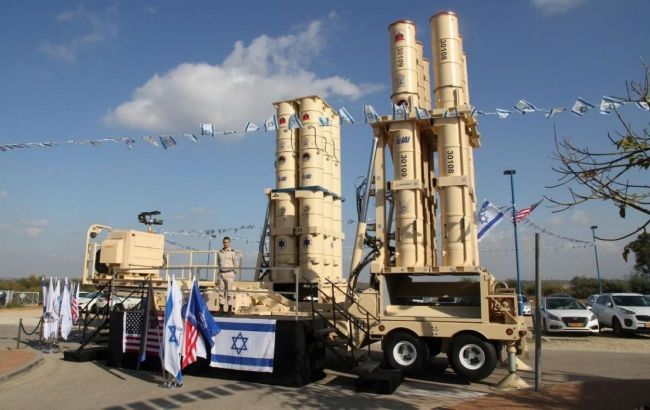Israel's superweapon: What is Arrow 3 air defense system capable of
 Arrow 3 (mod.gov.il)
Arrow 3 (mod.gov.il)
The Israeli Army has for the first time used the Arrow 3 system, which is the highest element of layered missile defense. They successfully intercepted a ballistic missile launched from Yemen without posing a threat to Israeli territory.
More details about the Arrow system and whether Ukraine has a chance to acquire it can be found in the article on RBC-Ukraine.
To prepare the story, the following sources were used: statements from the Israel Defense Forces (IDF), The Times of Israel, The Jerusalem Post, the Israel Aerospace Industries website, open data from Wikipedia, and comments from aviation and missile expert Valerii Romanenko for RBC-Ukraine.
Combat use against ballistic threats
The successful interception of a ballistic target was reported by the official IDF Twitter account.
"The IDF air defense system intercepted an airborne threat detected in the Red Sea area, south of the city of Eilat. There was no threat to the civilian population, and no penetration into Israeli territory was detected," the military reported, later specifying that the missile was intercepted "in the most favorable location."
This statement was made after residents of Eilat reported a loud explosion, and photos of the white trail in the sky from the interceptor missile were circulated on social media. No warning sirens were sounded.
 Photo: Trail from the launched Arrow 3 interceptor missile (t.me/Yediotnews)
Photo: Trail from the launched Arrow 3 interceptor missile (t.me/Yediotnews)
Local media reports suggest that this was the first operational use of the long-range Arrow 3 system. The ballistic missile of the ground-to-ground class was launched from the Red Sea area, potentially targeting the southern Israeli city of Eilat.
Responsibility for the incident was claimed by Yemeni Houthi rebels. Their representative, Yahya Saree, explained the strike as a "sense of religious and moral responsibility for the population of the Gaza Strip," where Israel is conducting a ground phase of the war against Hamas. He also threatened further attacks using drones and missiles.
The Houthi rebels have controlled the capital, Sanaa, and significant territories in Yemen since 2014. Their regime, like Hamas, is supported by Iran, which possesses up to 3,000 ballistic missiles of various ranges. Today, the Houthi resources have released a video of a ballistic missile launch towards Israel.
عمليات مشتركة للقوة الصاروخية اليمنية وسلاح الجو المسير على أهداف في عمق الكيان الإسرائيلي في فلسطين pic.twitter.com/HWI6Tc54YN
— الإعلام الحربي اليمني (@MMY1444) November 1, 2023
As stated by Boaz Levy, the CEO of Israel Aerospace Industries company, the Arrow 3 system has demonstrated the most advanced technology for defense against ballistic missiles. Israel has shown to Iran and other countries in the region that it has a truly reliable missile defense.
Development and global interest
Arrow 3 or Hetz 3 is a missile defense system within the Israeli missile defense system, developed in cooperation with the U.S. Missile Defense Agency and American companies.
Work on the Arrow project began in 1986. In 1988, Israel Aircraft Industries received an order to create a prototype of the Arrow 1 missile, which underwent testing until 1994. In the next phase, a missile defense system was developed capable of intercepting ballistic missiles launched from distances of up to 3,000 km at speeds of up to 4.5 km per second.
Arrow 2 missiles, capable of intercepting targets in the stratosphere, were delivered to the Israel Defense Forces, and the first battery was deployed south of Tel Aviv in 2002, with a second one in the north of the country near Hadera. It is considered that these deployed batteries provide coverage for 85% of Israel's territory. Testing of the Arrow 3 system began in 2011, and later it was revealed that the project was a joint American-Israeli effort.
"Israel wouldn't have been able to afford Arrow 3 on its own, and the U.S. has invested over $4 billion in its production. The point is that Americans are looking for partners to jointly develop expensive systems, just like European countries realized that developing combat aircraft together is more cost-effective. That's how consortia like Airbus, Eurofighter, and others came into being," explained expert Valerii Romanenko.

Photo: Arrow 3 testing in Alaska (iai.co.il)
In 2015, the Israeli Ministry of Defense announced the successful testing of the complex, which struck a test target over the Mediterranean Sea. There is also information about a series of secret joint tests conducted with the United States in Alaska. The Arrow 3 missile was put into operation in 2018.
According to experts, in fact, Arrow can be considered Israel's superweapon. It has attracted interest from several potential buyers, including Germany, which received approval for a $3.5 billion deal with the United States in the summer, with deployment planned to begin in 2025. However, it's unclear how the ongoing war between Israel and Hamas will impact these timelines.
Additionally, Poland, Romania, and Scandinavian countries, which have become more active because of Russian aggression in Ukraine, are considering the capabilities of the Israeli system as a hedge against ballistic missiles like the Iskander and Kinzhal.
"If you have Arrow 3, you can cover an area within a 100 km radius around its positions. The same goes for the Patriot, which has a coverage of only about 20-25 km. It's better to choose the former, even though it's more expensive, but it's more modern and requires fewer personnel to maintain. Compared to the Patriot, which requires a staff of 80-90 people," added Valerii Romanenko.
Features and specifications
The Arrow-3 missile defense system is positioned as a complex designed to intercept ballistic missiles, including intercontinental ones, in the exoatmosphere, essentially in space. The upper interception limit is 100 km or higher. The interception altitude primarily sets it apart from Patriot systems, which can intercept targets at most up to 30 km above the Earth.
"According to the classification of the International Aeronautical Federation (IAF), atmospheric altitude is considered to be up to 100 km, and anything higher is considered space. To avoid shooting down, for example, nuclear-tipped missiles right above itself, Israel decided to do this in space so that radioactive fallout wouldn't reach its territory," explained Romanenko.
The American THAAD system, which can reach targets at an altitude of 150-200 km, could pose competition to it. The United States currently has 7 such batteries, and several others have been acquired by the UAE, Japan, and South Korea. It was recorded that in January 2022, THAAD intercepted a ballistic missile that Yemeni Houthi rebels attempted to use to target an oil facility in the Emirates.
Ballistic defense is the primary and, one might say, the exclusive task of Arrow-3. Previously, representatives of the Israel Space Agency also mentioned that it could serve as an anti-satellite weapon. However, this would only apply to satellites in low orbit, clarified the expert.
The system consists of a hypersonic interceptor missile, launchers, an early warning radar station, and a command center. All components of the system are mobile and can be relocated to specially prepared sites.
Characteristics of the system
- Maximum interception altitude - 100 km (other sources claim up to 150 km)
- Operational range - 1,250 km (other sources claim up to 2,400 km or even up to 5,500 km)
- Target detection range - from 900 km (with the EL/M-2080 Block B Super Green radar) to 1,900 km (with the AN/TPY-2 radar)
The system is capable of detecting and tracking up to 12 targets and can guide up to two interceptors to a single target. One battery can intercept up to five ballistic missiles within 30 seconds, even before the destination of the enemy missile is known.
Among the manufacturer's asserted advantages are compactness, a large coverage area, high effectiveness against all types of tactical ballistic missiles, exceptional maneuverability, and a short reaction time. Moreover, the system is autonomous. The latter factor, among others, is quite attractive, as THAAD, in addition to being more expensive, is also tied to the American satellite system.

Photo: Arrow-3 missile launch (iai.co.il)
The Arrow-3 interceptor missile is a two-stage missile with an initial boost and a sustainer motor, as well as a special strike part.
"As for the warhead, there are two options. Some sources say it's conventional, meaning it explodes and damages the target with fragments, while others mention a kinetic method, which means destruction by direct impact. Both options are effective above 100 km, while at 20 km, there's no particular advantage to hitting with fragments because a ballistic missile is already flying vertically. At 100 km, there are chances to intercept on the ascending trajectory before it reaches its maximum altitude," explained Valerii Romanenko.
The manufacturer says the effectiveness is 99%, but it's too early to speak objectively. Until yesterday, there were only tests, even though Arrow-3 underwent its baptism of fire back in 2017 when it successfully intercepted a Syrian S-300 missile in Israeli airspace. According to Uzi Rubin, a scientific associate at the Jerusalem Institute for Security, that use was more non-standard and didn't give a clear indication of how effective it would be against ballistic threats. The Yemeni missile was a much more complex target and matched the Arrow's primary purpose.
The Arrow-3 missile uses a hit-to-kill technology. It is launched vertically and changes direction towards the calculated intercept point. Only after identifying the target and course does the interceptor destroy it by direct impact.
Missile characteristics
- Engine - two-stage
- Interception speed - hypersonic, up to 2.5 km/s
- Interception altitude - over 100 km
- Interception range - up to 2,400 km
- Cost - 2-3 million dollars
The incident with the Yemeni missile over the Red Sea shows that the Arrow-3 interceptor is indeed capable of shooting down ballistic missiles with a range of 400 to 2,000 kilometers, such as the Iranian Shahab-3 and Sejil, including those carrying weapons of mass destruction.
***
It is evident that considering all the advantages, the Arrow-3 system would be useful for the Ukrainian air defense forces in countering Russian Kinzhals and Iskanders. However, obtaining such systems is impossible for two reasons. Firstly, they are produced in limited quantities, and secondly, they are much more expensive than Patriot and SAMP-T.
"We don't have that kind of money in Ukraine, nor do our allies. They can't provide us with a sufficient quantity of Patriots. We only have two batteries for the whole of Ukraine, and that only covers one city. As for Arrow-3, Israel has only one battery, and discussions about deployment in Germany are still in the realm of possibility. Of course, if they prove to be highly effective, they will likely go into production. For now, it's an artificial product," summarized expert Valerii Romanenko.

